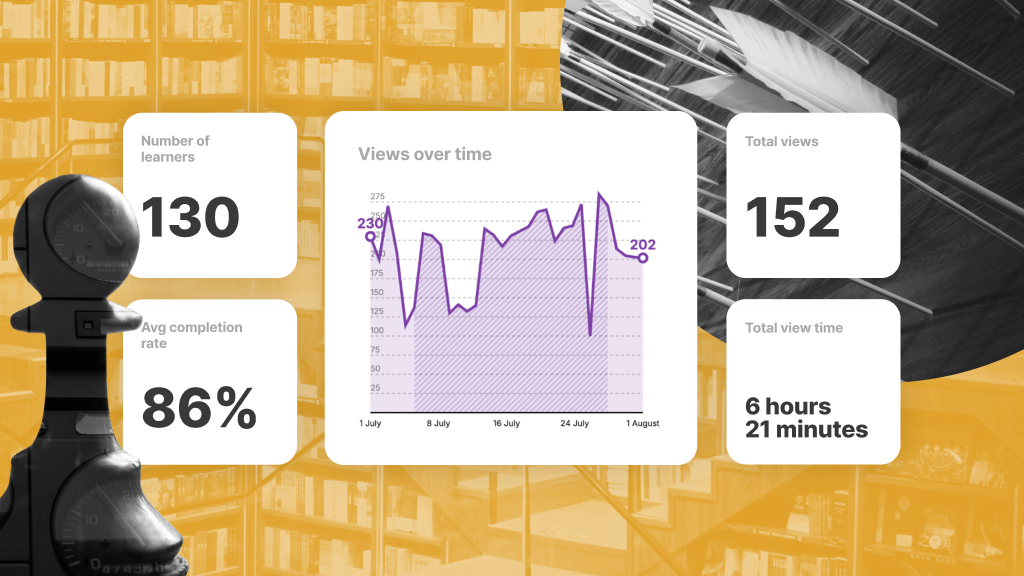Transfer of learning: The necessary step to make learning stick

Transfer of learning is a concept that should be top-of-mind when planning any learning and development program. Why? In a perfect world, the billions of dollars organizations collectively spend every year on training would be reflected in improvements in business outcomes. But the hard truth is, that isn’t the case.
In a global survey by McKinsey & Company, only 25% of respondents reported that their organization’s training programs resulted in a measurable improvement of business performance. Another survey of L&D professionals found that one year after a training intervention, only 34% of employees were applying what they learned.
Although ideally, employees would be able to apply newly acquired skills and knowledge immediately with great success, there is often a gulf between learning and job performance. This gulf can be difficult to bridge, unless L&D teams understand how transfer of learning occurs and what can help or hinder the process.
What is “transfer of learning”?
“Transfer of learning” refers to the application of learning to actual job performance. It’s influenced by a number of factors — some specific to learners, some to the training, and some to the organization itself.
Researchers from Wilson Learning compared 32 studies and developed a learning transfer model comprising three categories of activities that impact performance:
- Learner readiness activities, such as pre-testing of prior knowledge and prerequisite skills
- Learning transfer design activities, such as goal-setting and practice activities
- Organizational alignment activities, such as coaching by managers and peers
An employee’s readiness to learn and motivation to apply learning on the job has a substantial impact on the transfer of learning to their work. Their prior knowledge of the subject, and their ability to connect new information to prior knowledge, contributes as well.
When it comes to the training itself, it must be designed with the goal of learning transfer in mind. The relevance of the training to actual job performance is paramount. And from an organizational standpoint, the existence of a learning culture as well as visible support from leadership and peers is critical.
The different types of learning transfer
The terms “positive transfer,” “negative transfer,” and “zero transfer” are often used to describe the change employees see in their work performance after training. Respectively, these terms translate to: some improvement, a decrease in performance, or no change at all.
L&D teams will find it more helpful to think in terms of the degree of transfer needed, bearing in mind that real world application of a skill is always more complex than application in a training setting.
One study found that only 34% of employees were applying what they learned a year after training.
Think in terms of a continuum, with “near transfer” at one end and “far transfer” at the other. Near transfer of learning is needed when the training context and job performance context are very similar. Far transfer of learning is needed when the two are vastly dissimilar.
Near transfer may suffice for tasks that are repetitive and consistent, and employees can be trained in the “right” way to do things. The farthest degree of transfer is needed when employees need to exercise judgment and choose the right course of action from among a number of options based on the situation at hand.
In addition to positive, negative, zero, near, and far transfer, a few other types of transfer were identified in Dale H. Schunk’s book, Learning theories: an educational perspective:
- Literal transfer – the skill is performed on the job exactly as it was learned
- Figural transfer – general knowledge acquired in a previous situation is used to think or learn about a problem in a new situation
- Low road transfer – well-established skills learned in one situation transfer almost automatically to a new, but very similar, situation
- High road transfer – after careful evaluation of a situation, learning is mindfully applied to it
- Forward reaching transfer – during training, learners consider possible uses of newly acquired skills and knowledge
- Backward reaching transfer – learners think about previous situations in which newly acquired skills and knowledge could have applied
Factors that affect the transfer of learning
Efforts to ensure and measure the transfer of knowledge are often grounded in the 16 factors addressed in the Learning Transfer System Inventory (LTSI).
- Learner readiness (attitude and mindset for participating meaningfully in training)
- Performance self-efficacy (belief in one’s ability to apply learning on the job)
- Motivation to transfer (learners’ understanding that they and the organization will benefit)
- Transfer effort – performance expectation (belief that the effort to apply learning will change performance)
- Performance – outcome expectation (belief that changed performance will lead to valued outcomes)
- Performance coaching (about how the learning can be applied on the job)
- Supervisor support (for learning use on the job)
- Supervisor sanction (extent to which supervisors actively oppose the use of new skills and knowledge)
- Peer support (for using new approaches)
- Resistance to change (includes personal and organizational change)
- Personal outcome – positive (learners are rewarded for using new learning on the job)
- Personal outcome – negative (learners are not rewarded, or are penalized, for trying a new approach)
- Opportunity to use learning (the lack of chances to apply the learning)
- Personal capacity to transfer (how well new skills and knowledge have been learned)
- Perceived content validity (how much learners believe the training applies to their job)
- Transfer design (elements of the learning event that support transfer)
To make the LTSI useful as an assessment tool, Holton and his co-authors suggested specific survey items that are related to each factor. For example, to assess learner readiness, the LTSI includes such rating items as:
- “Prior to this training, I knew how the program was supposed to affect my performance.”
- “Before this training, I had a good understanding of how it would fit my job-related development.”
For perceived content validity, it includes:
- “The methods used in this training are very similar to how we do it on the job.”
- “The instructional aids used in this training are very similar to real things I use on the job.”
And for supervisor support, it includes:
- “My supervisor will meet with me regularly to work on problems I may be having in trying to use this training.”
- “My supervisor will help me set realistic goals for job performance based on my training.”
The LTSI has been refined several times during the 20+ years since its introduction and can be easily customized by L&D teams to meet their particular needs. One note of caution when using this or any other tool that relies on learners’ perceptions — those perceptions are highly subjective and should not be the sole measurement of learning transfer.
How to promote the transfer of learning
For any significant degree of positive transfer to occur, transfer of learning must be an underlying design principle for L&D teams. Designing for transfer begins with an understanding of the learning that needs to occur and how skills and knowledge will be applied in the workplace. That foundation makes it possible to design instructional activities that provide appropriate practice in a context that approximates real-world job performance.
Self-paced activities are effective for procedural learning objectives, which are aimed at the acquisition and transfer of rules and concepts. Procedural learning is applied primarily in straightforward situations where there is a right and wrong way of doing things.
L&D teams should design for transfer and play a key role in ensuring learner readiness.
Declarative learning objectives target higher-order cognitive processes and the far transfer of knowledge to situations involving multiple perspectives and complex decision-making. Self-paced activities may need to be supplemented with more collaborative instructional methods and supports, such as individual coaching over time.
Additional best practices for designing training programs that will improve the transfer of learning include:
- Bookending training by ensuring a receptive learner mindset on the front end and a supportive performance environment on the back end
- Finding ways for learners to connect what they’re learning to what they already know (e.g., through examples, analogies, and case studies)
- When learning occurs largely through self-instructional programs, creating opportunities for discussion and collaboration with others
- Providing multiple learning opportunities rather than a single training event
- Deciding up-front how and when transfer of learning will be measured, and then designing to those metrics
In addition to designing for transfer, L&D teams can play a key role in ensuring learner readiness. The Wilson learning transfer model identifies motivation to learn, intent to use, career goal alignment, and self-efficacy as transfer activities that have a major influence on job performance.
In other words, L&D teams can help ensure learner readiness by encouraging employees to have confidence in their capacity to learn, motivating them to practice and review what they’re learning, and helping them see that what they’re learning can support their career goals. It’s also important to provide positive consequences, during and after training, for the use of new skills and to encourage learners to participate in internal and external communities of practice.
Final note
Obtaining an accurate reading on the degree of learning transfer that has occurred requires L&D teams to avoid reliance on only subjective measures, such as self-reporting by learners. Asking learners to rate how well they think they will be able to apply what they’ve learned may be a measure of confidence, but it doesn’t provide much insight as to actual changes in job performance.
One way to address this is to develop specific accountability metrics to measure learning transfer as part of an organization’s formal performance assessment process. Supervisors and managers share those metrics with their teams and use them in monitoring job performance. Knowing upon going into a training that their performance assessment will reflect the application of that training can increase both retention and transfer of learning.
Develop specific accountability metrics to measure learning transfer as part of formal performance assessments.
Additionally, L&D teams could take a longer-term view of post-training changes in job performance. Few organizations allow enough time to pass before attempting an evaluation of learning transfer. In fact, a 2017 report found that only 19% of survey respondents gathered learner feedback eight weeks or more post-training, which the researchers identified as the “sweet spot where learning transfer and behavioral change can be observed and measured.”
These are just a few of the ways to support the transfer of learning. With a bit of mindfulness and reflective practice on the part of L&D teams, organizations will be better positioned to get the full value out of offering development opportunities for their employees.





